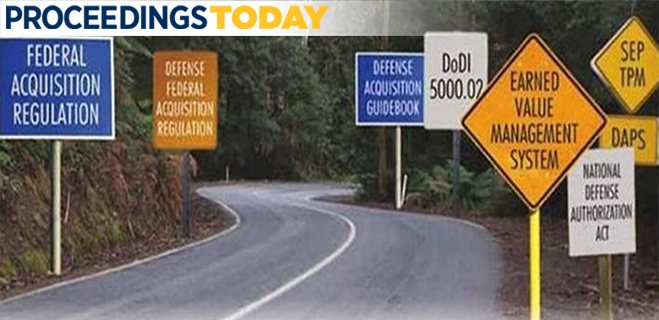
Active-duty professionals cannot fathom why they have had five different cell phones with dramatically increasing capability, yet they still carry radios their fathers used.
The Department of Defense (DOD) is notoriously slow to award contracts, slower to pay bills, and accustomed to stretching out periods of performance while reducing quantities—all of which increases corporate risk. Barriers to entry in the defense market are monumental. Companies that create innovative products rarely do business with DOD because of the Herculean overhead of even bidding on defense programs.
We need to focus on reforms that enable faster acquisitions. Both DOD and industry want speed. If we can make it faster to sell to DOD (and for companies to realize revenue), it likely also will be cheaper.
The government must also be fair, and industry must be profitable. Those interests may be different, but they are not at odds. New products from new vendors typically are more profitable. The best way to lower prices is through competition with new vendors, and new vendors will enter the market if the barriers are low enough. Therefore, simpler acquisition processes must be developed to benefit both parties.
Why Is the Defense Acquisition So Slow?
Risk Aversion. Fundamentally, the defense acquisition system is designed to avoid mistakes by layering oversight, process, procedure, documentation, and structure in a uniform manner on an incredible variety of acquisitions. The compliance requirements have become so onerous that few acquisition programs can comply effectively with them.
Decision Cycle. Between the Joint Capabilities Integration and Development System (JCIDS), which defines defense acquisition requirements and evaluation criteria, and the Planning, Programming, and Budget System (PPBS), DOD and Congress theoretically have ensured that a good idea can result in a funding stream in only a few years or more. By resolutely applying the military axiom of “plan early, plan often” a new idea may be forced to pass through six or more analyses (not including independent reviews) before being requested as a line item in a budget process that starts execution three years later.
DOD must assume higher allowable risk and act faster with only key information.
Why Is Defense Acquisition So Expensive?
Dragging out programs for decades raises costs; competition is the invisible hand that leads to lower costs. Yet DOD requires businesses to conform to such a myriad of regulations in even the simplest cases that few companies choose to remain or enter in business with DOD. Perversely, it is much easier for DOD to continue doing business with a few existing contractors than to engage with new company offering a disruptive technology the department wants. As a result, there are cases in which new companies with innovative products have been counseled to sell out to current DOD contractors.
DOD must enable many more new vendors to compete. The following reforms could bring in new competition, increase the speed of acquisition, and reduce costs.
· Make acquisitions smaller, evolutionary, and service-specific. · Seek to buy from new sources as a default. · Develop fewer, simpler requirements (5 vs. 500). · Assume more risk; accept early failure in one-third of programs. · Change the personal incentives in the government workforce; reward on time, budgetary savings, effectiveness. · Empower the workforce to make trades on process, manpower, and facilities while rewarding success and holding workforce accountable for failure. · Involve fewer people and organizations for oversight. · Provide programs more management reserve (time and money). |
· Allow departments to retain unexpended budget: reward cancellation of failed programs. · Cap multiyear budgets with authority to trade between research and development (R&D) and procurement funds. |
· Abandon notion of “industrial base” in almost every case.
· Stop decreeing how companies must work.
No doubt better acquisitions solutions are possible, and they should include measures of performance and estimated metrics for outcomes. In short, DOD should fail fast, reward saving (not spending), and create more and smaller programs. Fixing the process is not complicated; it is just hard. If we do not make it easier for new, innovative companies to participate then DOD risks falling behind our adversaries.
Lieutenant Colonel Waugh represents St. Mary’s and Calvert counties in the Maryland State Senate. Since 2007, he has been a member of the senior professional staff at the Johns Hopkins University Applied Physics Laboratory. He served 20 years in the Marine Corps, flying the AV-8B Harrier, with operational deployments on board ship and ashore, including two tours in acquisition.
More from Proceedings Today :
Don't Share Intel with the Bear ... Captain Dave Hanson, U.S. Navy (Retired)
Stop Politicizing Shipnames (Part II) ... Colonel Mark Cancian, U.S. Marine Corps (Retired)
80-Year-Old Drydocks Don't Cut it ... Lieutenant Sean Getway, U.S. Navy
Reduce U.S. Ground Forces in Korea? ... Captain Steve F. Kime, U.S. Navy (Retired)


